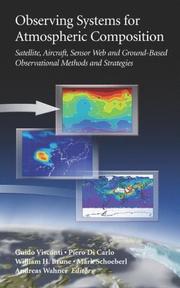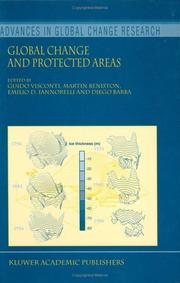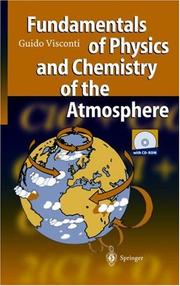| Listing 1 - 10 of 25 | << page >> |
Sort by
|

ISBN: 1280816171 9786610816170 038735848X 0387307192 1441921478 Year: 2007 Publisher: New York ; London : Springer,
Abstract | Keywords | Export | Availability | Bookmark
 Loading...
Loading...Choose an application
- Reference Manager
- EndNote
- RefWorks (Direct export to RefWorks)
The new challenge in atmospheric chemistry is to understand the intercontinental transport and transformation of gases and aerosols. This book describes the observational and modeling techniques used to understand the atmospheric composition from satellites, aircraft and ground based platforms. The two common ideas presented throughout are the role of each component in an observing system for atmospheric composition, and the advances necessary to improve the understanding of atmospheric composition. The objective of this book is to provide a larger audience the opportunity to learn about these techniques and advances in atmospheric composition.
Atmospheric chemistry. --- Meteorology --- Methodology. --- Chemistry, Physical and theoretical --- Atmospheric science --- Environmental protection. --- Geochemistry. --- Physical geography. --- Remote Sensing/Photogrammetry. --- Atmospheric Protection/Air Quality Control/Air Pollution. --- Geotechnical Engineering & Applied Earth Sciences. --- Environmental Physics. --- Geography --- Chemical composition of the earth --- Chemical geology --- Geological chemistry --- Geology, Chemical --- Chemistry --- Earth sciences --- Environmental quality management --- Protection of environment --- Environmental sciences --- Applied ecology --- Environmental engineering --- Environmental policy --- Environmental quality --- Remote sensing. --- Air pollution. --- Geotechnical engineering. --- Environmental sciences. --- Remote-sensing imagery --- Remote sensing systems --- Remote terrain sensing --- Sensing, Remote --- Terrain sensing, Remote --- Aerial photogrammetry --- Aerospace telemetry --- Detectors --- Space optics --- Environmental science --- Science --- Engineering, Geotechnical --- Geotechnics --- Geotechnology --- Engineering geology --- Air --- Air contaminants --- Air pollutants --- Air pollution --- Air pollution control --- Air toxics --- Airborne pollutants --- Atmosphere --- Contaminants, Air --- Control of air pollution --- Pollutants, Air --- Toxics, Air --- Pollution --- Air quality --- Atmospheric deposition --- Control
Book
ISBN: 3319294474 3319294490 Year: 2016 Publisher: Cham : Springer International Publishing : Imprint: Springer,
Abstract | Keywords | Export | Availability | Bookmark
 Loading...
Loading...Choose an application
- Reference Manager
- EndNote
- RefWorks (Direct export to RefWorks)
This book is an introductory course to the physics and chemistry of the atmosphere and to climate dynamics. It covers the basics in thermodynamics, fluid dynamics, radiation, and chemistry and explains the most intriguing problems that currently exist in the study of the atmospheres of the Earth and planets. A particular effort is made to approach the different topics intuitively. Among the themes covered are the most recent evolution concerning the chemistry of polluted troposphere, the global warming problem, and chaos and non linear theory. The book is almost completely rewritten in comparison to the previous edition, with a more logical organization of the chapters. The fundamentals of thermodynamics, radiation, fluid dynamics and chemistry are introduced in the first six chapters including a new chapter on remote sensing. Also there is an additional chapter on Geoengineering. A significant addition to the new edition, at the end of each chapter, are the Examples where the topics introduced in the chapter are further discussed with application to classical problems or new research items. Many of these examples are accompanied by computer programs. The most important update deals with the theory of the general circulation, the methods to evaluate GCM, the detailed discussion of the urban troposphere and the chaos and non linear phenomena.
Earth sciences. --- Climatology. --- Atmospheric sciences. --- Remote sensing. --- Earth Sciences. --- Atmospheric Sciences. --- Remote Sensing/Photogrammetry. --- Atmospheric physics. --- Atmospheric chemistry. --- Aerophysics --- Atmospheric sciences --- Physical meteorology --- Chemistry, Physical and theoretical --- Geophysics --- Atmospheric science --- Meteorology, Physical --- Climate --- Climate science --- Climate sciences --- Science of climate --- Remote-sensing imagery --- Remote sensing systems --- Remote terrain sensing --- Sensing, Remote --- Terrain sensing, Remote --- Aerial photogrammetry --- Aerospace telemetry --- Detectors --- Space optics --- Earth sciences --- Atmosphere
Book
ISBN: 3319656694 3319656686 Year: 2018 Publisher: Cham : Springer International Publishing : Imprint: Springer,
Abstract | Keywords | Export | Availability | Bookmark
 Loading...
Loading...Choose an application
- Reference Manager
- EndNote
- RefWorks (Direct export to RefWorks)
This book is a critical appraisal of the status of the so-called Climate Sciences (CS). These are contributed by many other basic sciences like physics, geology, chemistry and as such employ theoretical and experimental methods. In the last few decades most of the CS have been identified with the global warming problem and numerical models have been used as the main tool for their investigations. The produced predictions can only be partially tested against experimental data and may represent one of the reasons CS are drifting away from the route of the scientific method. On the other hand the study of climate faces many other interesting and mostly unsolved problems (think about ice ages) whose solution could clarify how the climatic system works. As for the global warming, while its existence is largely proved, scientifically it can be solved only with a large experimental effort carried out for a few decades. Problems can arise when not proved hypotheses are adopted as the basis for public policy without the recognition that they may be on shaky ground. The strong interactions of the Global Warming (GW) with the society create another huge problem of political nature for the CS. The book argues that the knowledge gained so far on the specific GW problem is enough for the relevant political decisions to be taken and that Climate Science should resume the study of the climate system with appropriate means and methods. The book introduces the most relevant concepts needed for the discussion in the text or in appropriate appendices and it is directed to the general public with upper undergraduate background. Each chapter closes with a debate between a climate scientist and a humanist to reflect the discussions between climate science and philosophy or climate scientists and society.
Environment. --- Climate change. --- Political science. --- Philosophy and science. --- Atmospheric sciences. --- Climate Change. --- Climate Change Management and Policy. --- Atmospheric Sciences. --- Philosophy of Science. --- Environment Studies. --- Political Science. --- Climatology. --- Climate --- Climate science --- Climate sciences --- Science of climate --- Atmospheric science --- Meteorology --- Climatic changes. --- Science --- Philosophy. --- Administration --- Civil government --- Commonwealth, The --- Government --- Political theory --- Political thought --- Politics --- Science, Political --- Social sciences --- State, The --- Changes, Climatic --- Changes in climate --- Climate change --- Climate change science --- Climate changes --- Climate variations --- Climatic change --- Climatic changes --- Climatic fluctuations --- Climatic variations --- Global climate changes --- Global climatic changes --- Climatology --- Climate change mitigation --- Teleconnections (Climatology) --- Normal science --- Philosophy of science --- Environmental aspects --- Science and philosophy --- Atmospheric sciences --- Earth sciences --- Atmosphere --- Global environmental change --- Balance of nature --- Biology --- Bionomics --- Ecological processes --- Ecological science --- Ecological sciences --- Environment --- Environmental biology --- Oecology --- Environmental sciences --- Population biology --- Ecology

ISBN: 0306480514 0792369181 9048156866 Year: 2003 Publisher: New York : Kluwer Academic Publishers,
Abstract | Keywords | Export | Availability | Bookmark
 Loading...
Loading...Choose an application
- Reference Manager
- EndNote
- RefWorks (Direct export to RefWorks)
High mountains can be considered as particularly appropriate environments to detect effects ofclimate change on natural biocoenoses in a global scale for the following reasons: Firstly, ecosystems at the l- temperature limits of plant life are generally thought to be especially sensitive to climate change [1][2][3]. An already ongoing upward shift of vascular plants at high summits in the Alps, determined by the Austrian IGBP-research [4][5][6][7][8], is most likely a response to the atmospheric warming since the 19th century. Secondly, high mountains still comprise the most natural ecosystems in many countries, being largely untouched by human settlements and agricultural influences, Therefore, climatic effects on ecosystems can be studied without masking effects from human land use. Thirdly, high mountain ranges are present in virtually every major zonobiome of the earth. The research initiative GLORIA aims to establish an urgently needed global monitoring network, by using high mountain ecosystems as sensitive indicators, as required in the “IGBP-Mountain Workplan” [9]. Moreover, a deeper understanding of assemblagemechanisms andassemblage processes in vegetation patterns as a contribution to ecological theory can be expected. This paper gives a short general overview about GLORIA and a first outline about the concept, method, and some few results of the “Multi Summit-Approach”, one of the basic intentions within the proposed network. It aims to encourage the involvement of high mountain researchers and research co-ordinators in a detailed discussion of the proposed research activities and in a co-operation within the planned global monitoring network.
Global environmental change. --- Protected areas. --- Geology. --- Hydraulic engineering. --- Ecology. --- Environmental management. --- Hydrogeology. --- Atmospheric Sciences. --- Environmental Management. --- Atmospheric sciences. --- Ecology . --- Environmental stewardship --- Stewardship, Environmental --- Environmental sciences --- Management --- Balance of nature --- Biology --- Bionomics --- Ecological processes --- Ecological science --- Ecological sciences --- Environment --- Environmental biology --- Oecology --- Population biology --- Atmospheric sciences --- Earth sciences --- Atmosphere --- Geohydrology --- Geology --- Hydrology --- Groundwater --- Geognosy --- Geoscience --- Natural history --- Ecology
Book
ISBN: 3030747131 3030747123 Year: 2021 Publisher: Cham, Switzerland : Springer,
Abstract | Keywords | Export | Availability | Bookmark
 Loading...
Loading...Choose an application
- Reference Manager
- EndNote
- RefWorks (Direct export to RefWorks)
Exobiology. --- Climate, general. --- Astrobiology --- Biology --- Habitable planets --- Life --- Origin
Book
ISBN: 3031315391 3031315383 Year: 2023 Publisher: Cham : Springer International Publishing : Imprint: Springer,
Abstract | Keywords | Export | Availability | Bookmark
 Loading...
Loading...Choose an application
- Reference Manager
- EndNote
- RefWorks (Direct export to RefWorks)
The book is conceived at two levels. An introductory one intended for undergraduate and/or environmental studies students and the other (in the appendix) for advanced students (graduate). The book is different from others on the same subject which are either too descriptive or too much specialized. Beside there are large sections on biogeochemistry not usually found in other textbooks. Whenever possible an approach based on entropy considerations is introduced. The book includes a quite classical introduction to the thermodynamics of ocean and atmosphere, then the circulation of the ocean and atmosphere, the connection climate-chemistry with main emphasis on the carbon dioxide problem. The chemistry is also considered in connection with the polluted atmosphere and ocean and particulate in the atmosphere . A chapter is dedicated to the biogeochemical cycles which are solved both with the integration of a system of equations or matrix algebra. An original chapter is dedicated to sea-atmosphere interactions which includes the monsoons meteorology, hurricanes and the ENSO phenomena. Finally a concise description of the fluid environments in the Solar System is given.
Atmospheric science. --- Ocean-atmosphere interaction. --- Atmospheric sciences --- Earth sciences --- Atmosphere --- Air-sea interaction --- Air-sea interactions --- Atmosphere-ocean interaction --- Atmosphere-ocean interactions --- Atmospheric-oceanic interactions --- Interaction of atmosphere and ocean --- Interactions of atmosphere and ocean --- Ocean-meteorological relations --- Oceanic-atmospheric interactions --- Sea-air interaction --- Sea-air interactions --- Marine meteorology --- Physical oceanography --- Teleconnections (Climatology) --- Physical geography. --- Oceanography. --- Earth System Sciences. --- Atmospheric Science. --- Ocean Sciences. --- Oceanology --- Thalassography --- Marine sciences --- Geography

ISBN: 9783540674207 3540674209 Year: 2001 Publisher: Berlin: Springer,
Abstract | Keywords | Export | Availability | Bookmark
 Loading...
Loading...Choose an application
- Reference Manager
- EndNote
- RefWorks (Direct export to RefWorks)
Digital
ISBN: 9783319294490 Year: 2016 Publisher: Cham Springer International Publishing
Abstract | Keywords | Export | Availability | Bookmark
 Loading...
Loading...Choose an application
- Reference Manager
- EndNote
- RefWorks (Direct export to RefWorks)
This book is an introductory course to the physics and chemistry of the atmosphere and to climate dynamics. It covers the basics in thermodynamics, fluid dynamics, radiation, and chemistry and explains the most intriguing problems that currently exist in the study of the atmospheres of the Earth and planets. A particular effort is made to approach the different topics intuitively. Among the themes covered are the most recent evolution concerning the chemistry of polluted troposphere, the global warming problem, and chaos and non linear theory. The book is almost completely rewritten in comparison to the previous edition, with a more logical organization of the chapters. The fundamentals of thermodynamics, radiation, fluid dynamics and chemistry are introduced in the first six chapters including a new chapter on remote sensing. Also there is an additional chapter on Geoengineering. A significant addition to the new edition, at the end of each chapter, are the Examples where the topics introduced in the chapter are further discussed with application to classical problems or new research items. Many of these examples are accompanied by computer programs. The most important update deals with the theory of the general circulation, the methods to evaluate GCM, the detailed discussion of the urban troposphere and the chaos and non linear phenomena.
Space research --- Geodesy. Cartography --- Meteorology. Climatology --- Geology. Earth sciences --- thermodynamica --- atmosfeerchemie --- atmosfeerfysica --- fotogrammetrie --- metrologie --- remote sensing --- klimatologie --- geografie --- geologie --- aarde (astronomie) --- sensoren --- atmosfeer
Digital
ISBN: 9783319656694 9783319656687 Year: 2018 Publisher: Cham Springer
Abstract | Keywords | Export | Availability | Bookmark
 Loading...
Loading...Choose an application
- Reference Manager
- EndNote
- RefWorks (Direct export to RefWorks)
This book is a critical appraisal of the status of the so-called Climate Sciences (CS). These are contributed by many other basic sciences like physics, geology, chemistry and as such employ theoretical and experimental methods. In the last few decades most of the CS have been identified with the global warming problem and numerical models have been used as the main tool for their investigations. The produced predictions can only be partially tested against experimental data and may represent one of the reasons CS are drifting away from the route of the scientific method. On the other hand the study of climate faces many other interesting and mostly unsolved problems (think about ice ages) whose solution could clarify how the climatic system works. As for the global warming, while its existence is largely proved, scientifically it can be solved only with a large experimental effort carried out for a few decades. Problems can arise when not proved hypotheses are adopted as the basis for public policy without the recognition that they may be on shaky ground. The strong interactions of the Global Warming (GW) with the society create another huge problem of political nature for the CS. The book argues that the knowledge gained so far on the specific GW problem is enough for the relevant political decisions to be taken and that Climate Science should resume the study of the climate system with appropriate means and methods. The book introduces the most relevant concepts needed for the discussion in the text or in appropriate appendices and it is directed to the general public with upper undergraduate background. Each chapter closes with a debate between a climate scientist and a humanist to reflect the discussions between climate science and philosophy or climate scientists and society.
Philosophy of science --- Politics --- Nature protection --- Meteorology. Climatology --- Environmental protection. Environmental technology --- atmosfeerchemie --- environment --- atmosfeerfysica --- metrologie --- politiek --- wetenschapsfilosofie --- natuurbescherming --- atmosfeer --- klimaatverandering --- broeikaseffect
Digital
ISBN: 9783030747138 9783030747145 9783030747152 9783030747121 Year: 2021 Publisher: Cham Springer International Publishing
Abstract | Keywords | Export | Availability | Bookmark
 Loading...
Loading...Choose an application
- Reference Manager
- EndNote
- RefWorks (Direct export to RefWorks)
This book presents the result of an innovative challenge, to create a systematic literature overview driven by machine-generated content. Questions and related keywords were prepared for the machine to query, discover, collate and structure by Artificial Intelligence (AI) clustering. The AI-based approach seemed especially suitable to provide an innovative perspective as the topics are indeed both complex, interdisciplinary and multidisciplinary, for example, climate, planetary and evolution sciences. Springer Nature has published much on these topics in its journals over the years, so the challenge was for the machine to identify the most relevant content and present it in a structured way that the reader would find useful. The automatically generated literature summaries in this book are intended as a springboard to further discoverability. They are particularly useful to readers with limited time, looking to learn more about the subject quickly and especially if they are new to the topics. Springer Nature seeks to support anyone who needs a fast and effective start in their content discovery journey, from the undergraduate student exploring interdisciplinary content, to Master- or PhD-thesis developing research questions, to the practitioner seeking support materials, this book can serve as an inspiration, to name a few examples. It is important to us as a publisher to make the advances in technology easily accessible to our authors and find new ways of AI-based author services that allow human-machine interaction to generate readable, usable, collated, research content.
Solar system --- Meteorology. Climatology --- Evolution. Phylogeny --- Biology --- zonnestelsel --- biologie --- klimatologie --- evolutieleer --- ruimte (astronomie) --- planeten
| Listing 1 - 10 of 25 | << page >> |
Sort by
|

 Search
Search Feedback
Feedback About UniCat
About UniCat  Help
Help News
News